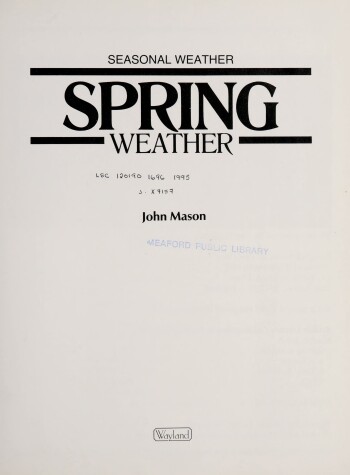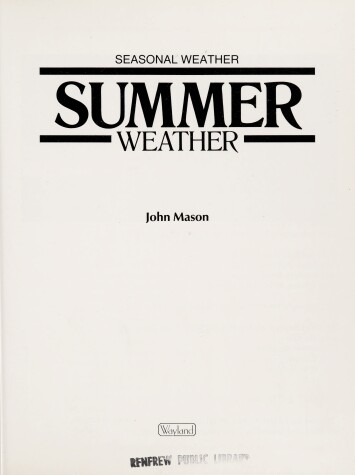Seasonal Weather
3 primary works • 4 total works
Book 1
How the weather changes from one season to the next has an important effect on most people's lives. This illustrated series of books describes and explains the type of weather associated with each season of the year. International in outlook, the books cover the important characteristics of weather in different parts of the world as well as general weather topics as appropriate to each season. Topical environmental issues which affect climate are discussed, and there is a series of practical experiments which children can do in relation to measuring or observing the weather. This book describes the type of weather associated with autumn, and why such weather occurs. Autumn is a season of very changeable weather. The book describes this transitional period between summer and winter when long, warm sunny days give way to colder, shorter ones. The book describes the formation of autumn mists, fog and frosts as well as the destructive storms that devastate many parts of the world at this time of the year. Despite this, autumn is also a season of immense beauty. The book describes how autumn weather affects the natural enviroment, particularly plants and crops.
The author also shows the problems the weather causes to farmers in parts of the world when the weather is unpredictable. The books shows how autumn weather is forecasted, and discusses how the long-term climate of the earth may be changing.
The author also shows the problems the weather causes to farmers in parts of the world when the weather is unpredictable. The books shows how autumn weather is forecasted, and discusses how the long-term climate of the earth may be changing.
Book 2
How the weather changes from one season to the next has an important effect on most people's lives. This illustrated series of books describes and explains the type of weather associated with each season of the year. International in outlook, the books cover the important characteristics of weather in different part of the world as well as general weather topics as appropriate to each season. Topical environmental issues which affect climate are discussed, and there is a series of practical experiments that children can do in relation to measuring or observing the weather. Spring is a changeable season, when the short, cold days of winter turn into long, warm summer days. This book shows how the coming of spring affects the weather in different parts of the world, especially in the temperate regions. The book shows how the wind is created and where local spring winds blow. The formation of clouds and showers are described, and we are shown the beautiful effects caused by the sea and rain together as rainbows. There is a section which shows weather fronts and their sequence of cloud and rain, and also how to predict and forecast spring weather.
Finally the book shows the effect of warm spring weather on the Earth's ozone layer and what we can do to stop its destruction.
Finally the book shows the effect of warm spring weather on the Earth's ozone layer and what we can do to stop its destruction.
Book 3
This is one of a series of books describing the different types of seasonal weather.The books cover the characteristics of weather in different parts of the world as well as general weather topics as appropriate to each season. Environmental issues which affect the climate are discussed and there is a series of practical experiments that children can do in relation to measuring or observing the weather. This book concentrates on the type of weather associated with summer, why it occurs, how it affects people's lives and what summer conditions are like in different parts of the world. This includes deserts, temperate regions and tropical lands. This book also shows how rain, hail, thunder and lightening are formed, as well as tornadoes and waterspouts which cross land and sea. There is a section which shows the environmental effect that global warming has on the planet.
How the weather changes from one season to the next has an important effect on most people's lives. This illustrated series of books describes and explains the type of weather associated with each season of the year. International in outlook, the books cover the important characteristics of weather in different parts of the world as well as general weather topics as appropriate to each season. Topical environmental issues which affect climate are discussed, and there is a series of practical experiments that children can do in relation to measuring or observing the weather. This book describes the type of weather associated with winter, and why such weather occurs. Winter usually means a season of long, dark evenings, ice and snow. In this book the author explains why such weather occurs, including the formation of clouds, fog and frosts. It shows how the seasons happen, and what parts of the world experience winter weather. Covering both the nothern and southern hemisphere, it describes winter in the temperate regions of the world, and bitterly cold winters near the poles. It highlights any particularly interesting or unusual weather that is experienced in winter.
The book shows how winter weather is forecasted and discusses the changing climate of the Earth in the past and predicts the future.
The book shows how winter weather is forecasted and discusses the changing climate of the Earth in the past and predicts the future.


